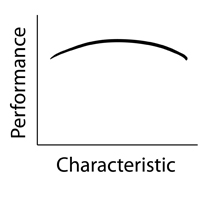Last week I attended the Society for Industrial & Organizational Psychology (SIOP) conference, my favorite. For me, the resonant theme was achieving a balance—in many areas. It was particularly timely given my involvement with a client wrestling with a team of extraordinarily talented individuals who have difficulty working together.
I want to focus on three qualities in leaders which may be assets or liabilities, depending on how they are utilized and how well they fit the situation. These three qualities are strengths, openness, and mental ability.

Much has been written about the benefits of specific strengths in leadership. Some work has carried this research further, and revealed how often strengths become liabilities. Assertive leaders can cross the line to domineering. Technically knowledgeable leaders can become micro-managers.
The key here is to understand how your leaders are utilizing their strengths. Leverage these strengths but make sure they are held in balance with contrasting characteristics such as good listening skills and openness.
Which brings me to the next quality—openness. While I don’t have statistical evidence, I frequently hear executives praise leaders for their decisiveness and ability to bring issues to closure. This decisiveness is often accompanied with a low amount of openness, a factor of the Big Five, or Five Factor Model of personality.
We can easily imagine situations where a decisive leader, one with low openness may be good at making decisions but less effective when it comes to gathering information in order to make a well-informed and comprehensive decision.
We also must look at the specific task at hand. For example, the leader of a task force exploring future strategies must be open to new ideas and thoughts, i.e. have a high degree of openness. On the other hand, a group working to complete a long-term project requires a leader converging on solutions and closing the project down. These may require a low amount of openness. Here we can see situations where there may be an optimal amount of openness for each job.
Similarly, consider the leader’s level of intelligence and the relationship to their performance. We expect that leaders with low levels of intelligence will have lower performance than those of higher intelligence, and research bears that out. Interestingly enough, once a certain level of intelligence is reached, performance begins to decline with increasing intelligence.
While we can easily imagine the difficulties with a leader who is not too bright, it may be difficult to understand how too much intelligence becomes detrimental. Consider for a moment a brilliant executive with a high business acumen. While he may be good at business analysis and strategy, imagine he is unable to communicate this strategy and motivate his team to implement it. Illuminated in this fashion, his brilliance seems doomed to failure.
So it may be good to consider your own leadership style. Do you have strengths you are leaning on and therefore possibly overusing? How might you balance these strengths in order to move from being a good leader to a superior one?
Concepts:
- When reviewing required leader characteristics for a job, consider the ramifications if a leader goes overboard on those characteristics.
- When evaluating a leader, consider the leader’s strengths and the consequences if he or she overusing this strength.
Keyword: leadership, balance, strengths
References:
- Ghiselli, E. E. (1963). Intelligence and managerial success. Psychological Reports, 12, 898.
- Kaiser, R., & Hogan, J. (2011). Personality, leader behavior, and overdoing it. Consulting Psychology Journal, 63(4), 219-242.
- Kaiser, R. B., & Hogan, J. (2012) Personality, leader behavior, and overdoing it: Empirical links. In R. B. Kaiser (Chair), Theory-driven, personality-based leadership development. Symposium conducted at the meeting of Society for Industrial & Organizational Psychology 2010, San Diego, CA, USA.
- Kaiser, R. B., & Overfield, D. V. (2010) Strengths, Strengths Overused, and Lopsided Leadership. In R. B. Kaiser (Chair), The trouble with the strengths fad. Symposium conducted at the meeting of Society for Industrial & Organizational Psychology 2010, Atlanta, GA, USA.
- Kaplan, R. E., & Kaiser, R. B. (2009). Stop overdoing your strengths. Harvard Business Review, 87(2), 100-103.
- Sharer, K. (2012). Interview by Thomas Fleming : Why I’m a listener: Amgen CEO Kevin Sharer. McKinsey Quarterly.

